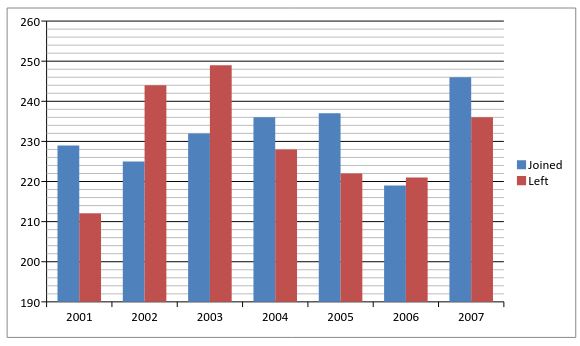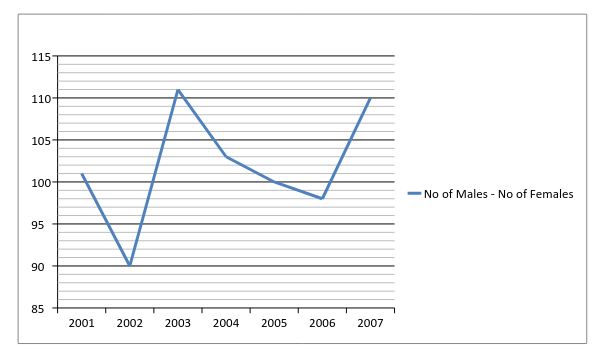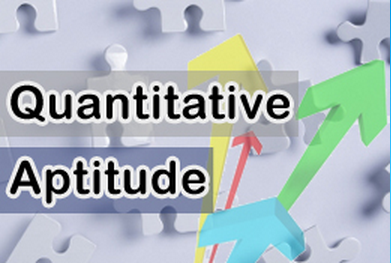Hello Aspirants.
Welcome to Online Reasoning Section with the explanation in AffairsCloud.com. Here we are creating Best question samples for IBPS PO 2017. We have included Some questions that are repeatedly asked in bank exams !!!
Click Here to View Cumulus Course: IBPS PO 2017
IBPS PO 2017: Reasoning Test– 6 PM Every Day
IBPS PO 2017: Quants Test– 7 PM Every Day
Q(1-5). Study the following Bar chart and answer the following questions
Given Bar chart represents no of workers joining and leaving a company from 2001 to 2007. No of workers at the end of the year of 2000 is 2000.Line Graph represents no of Male workers more than Female workers at end of the years from 2001 to 2007.


- At end of which year no of Maximum no of Male worked?
A. 2001
B. 2004
C. 2005
D. 2006
E. 2007E. 2007
Solution:
At end of Year 2001:
No of workers : 2000+229-212 = 2017 = M+F
M-F = 101
Males = 1059 Females = 958
At end of Year 2002:
No of workers : 2017+225-244 = 1998 = M+F
M-F = 90
Males = 1044 Females = 954
At end of Year 2003:
No of workers : 1998+232-249 = 1981 = M+F
M-F = 111
Males = 1046 Females = 935
At end of Year 2004:
No of workers : 1981+236-228 = 1989 = M+F
M-F = 103
Males= 1046 Females = 943
At end of Year 2005:
No of workers : 1989+237-222 = 2004 = M+F
M-F = 100
Males = 1052 Females = 952
At end of Year 2006:
No of workers : 2004+ 219-221 =2002 =M+F
M-F = 98
Males = 1050 Females =952
At end of Year 2007:
No of workers : 2002+246-236 = 2012 = M+F
M-F = 110
Males = 1061 Females = 951 - At the end of how many years no of workers in company is less than 2000?
A. One
B. Two
C. Three
D. Four
E. NoneC. Three - Maximum no of employees are working at end of which year?
A. 2001
B. 2005
C. 2006
D. 2007
E. NoneA. 2001 - At end of which year minimum no of females are working?
A. 2002
B. 2003
C. 2004
D. 2005
E. 2006B. 2003 - How many no of Females left at end of year 2004?
A. 16
B. 23
C. 24
D. 27
E. Cannot be determinedE. Cannot be determined
Q(6-10). Each question contains statement followed Quantity I and Quantity II. Find the relationship between both the quantities.
- Find the initial quantity of milk in the container
Quantity I : If pure milk contained in container is 125 litres after replacing 36 litres of water for three times
Quantity II: If pure milk contained in container is 64 litres after replacing 72 litres of water for three times
A. Quantity I > Quantity II
B. Quantity I < Quantity II
C. Quantity I ≥ Quantity II
D. Quantity I ≤ Quantity II
E. Quantity I = Quantity II or relationship cannot be establishedE. Quantity I = Quantity II or relationship cannot be established
Solution:
In both statements initial mixture is 216 litres. - Ram and Rahim invested a total sum of Rs.20,000 for 6 & 8 months respectively. They divided the profits in the ratio of 3:2.
Quantity I: Ram’s Investment
Quantity II : Rahim’s investment
A. Quantity I > Quantity II
B. Quantity I < Quantity II
C. Quantity I ≥ Quantity II
D. Quantity I ≤ Quantity II
E. Quantity I = Quantity II or relationship cannot be establishedA. Quantity I > Quantity II
Solution:
Since profit made by Ram is more than Rahim despite of his investment period less than Rahim. - From a pack of 52 cards a card is drawn at random
Quantity I : The probability of card being Heart or Queen?
Quantity II : The probability of card being Black or Queen?
A. Quantity I > Quantity II
B. Quantity I < Quantity II
C. Quantity I ≥ Quantity II
D. Quantity I ≤ Quantity II
E. Quantity I = Quantity II or relationship cannot be establishedB. Quantity I < Quantity II
Solution:
4/13 < 7/13 - What is the compound interest?
Quantity I . Rs 5000 is lent at 10% interest for 3 years compounded annually
Quantity II. Rs 3800 is lent at 20% interest for 2 years compounded annually
A. Quantity I > Quantity II
B. Quantity I < Quantity II
C. Quantity I ≥ Quantity II
D. Quantity I ≤ Quantity II
E. Quantity I = Quantity II or relationship cannot be establishedB. Quantity I < Quantity II
Solution:
Quantity I : 5000(1+10/100) 3 – 5000 = 1655
Quantity II : 3800(1+20/100) 2 – 3800 = 1672 - A shopkeeper sold two articles for Rs 3000. He gained 20% in total then what is cost price ?
Quantity I : If profit % on article 1 is 10%
Quantity I : If profit % on article 2 is 25%
A. Quantity I > Quantity II
B. Quantity I < Quantity II
C. Quantity I ≥ Quantity II
D. Quantity I ≤ Quantity II
E. Quantity I = Quantity II or relationship cannot be establishedB. Quantity I < Quantity II
Solution:
3000*120/100 = x(110/100) + (3000-x)* 125/100
X = 1000



